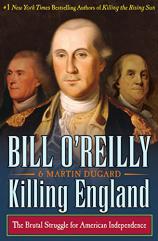Killing England: The Brutal Struggle for American Independence
Review
Killing England: The Brutal Struggle for American Independence
Bill O’Reilly and his co-author, Martin Dugard, have become world-famous for their series of well-researched historical books. Their stories --- from American presidents to military generals, true tales from World War II and, of course, the life and death of Jesus of Nazareth --- are fascinating treatments of rich world history.
The latest entry in their Killing series is KILLING ENGLAND. England has plunged into the setting of its new discoveries in the Western Hemisphere, from the British West Indies to a great land mass bordering the Atlantic Ocean. The 13 American colonies are each governed by individuals appointed by King George and the British Parliament. They function as separate units, each with a militia. Their leaders meet together, under British rule, to grind out matters of importance to all.
By July 1755, the British Army has been conducting skirmishes with French military units in the northern areas of its territory that shares borders with Canada, settled by the French. France has enlisted help from several Native tribes, such as the Iroquois, Sac and Fox, among countless others. When militias from the American colonies join with British troops to fight, they meet first with artillery but end in hand-to-hand mortal combat. The Indian fighters are cunning, brutal and skilled in forest battle.
It is within the confines of this French and Indian War, or Seven Years’ War, that we meet a Virginia militiaman named George Washington. Loyal to the crown, the former surveyor has arrived at Fort Duquesne, a French garrison. Although his men attack and kill a French scouting party, he is humiliated soon after by surrendering his men at Fort Necessity. They are released and return home, but carry the stigma of a loss. The prologue’s glimpse of Washington as a young officer immediately draws the reader into his personal story.
"This well-told account, with detailed documentation of all subjects, makes one proud of the memories these great leaders instilled in a people wanting a country of their own. KILLING ENGLAND could well become a staple in the study of the American Revolution."
O’Reilly and Dugard switch scenes with ease, next introducing the venerated person of Benjamin Franklin, the inventor, scientist and postmaster. His eccentricities are well-documented, including his philandering eye with the ladies. Franklin is concerned about the growing French threat and has doubts about the abilities of British Major General Edward Braddock. He feels that Braddock will not be up to wilderness fighting with the French-Indian alliance, fearing for the safety of the colonial folks. Washington enters the Ohio fighting for the British, hoping to gain back public esteem. Behind him, the British make sport of his military aptitudes.
Battling for superiority in the New World has taken a toll on England’s finances, as Parliament taxes heavily the items supplied to them. In harbor towns, such as Boston and New York, taxation becomes a burden on the goods shipped into their ports. The colonists have no say in the workings of Parliament. Finally, “No Taxation Without Representation” becomes a common cry for attention. In Boston, the entire cargo of English tea gets dumped into the harbor, a new kind of “tea party.”
Franklin and representatives from the colonies meet in Philadelphia to discuss their options for safety and well-being. Each chapter is documented with extensive footnotes that depict behind-the-scenes realities on numerous topics. The meetings take place in the Pennsylvania State House Assembly Room, later changed to Independence Hall. (Before reading KILLING ENGLAND, I had visited Philadelphia for about a week, savoring the historical monuments and buildings there that bring the rich American struggle to life.)
The men assembled there had opposed the Intolerable Acts of 1774, likening this “taxation without representation to a form of slavery.” The British had added insult to injury by dissolving the Massachusetts assembly and appointing a British general as governor. Franklin’s anger rises to a boiling point, giving him a cry for an army to drive out the English who control them. He gets his army, with a General appointed to lead the colonial soldiers --- George Washington.
O’Reilly and Dugard share a propensity for engaging their audience with the inner personalities as well as the public accomplishments of the incredibly talented founders of our United States of America. Thomas Jefferson sits on the committee of five to draw up a purposeful reasoning for independence from British rule. Reluctant, the young man is drafted to pen the actual words, which others in the group will edit. Instead of returning to his home at Monticello to be with his pregnant wife, he writes daily in a sweltering tavern room. Alexander Hamilton, John Adams and James Monroe are just a few of the key figures fully developed here.
The agony of war in one’s homeland, years of small triumphs, bitter defeats, endless winters, little food, no uniforms, threadbare clothing, bare feet and useless weaponry all combine for an excruciating path to freedom. This well-told account, with detailed documentation of all subjects, makes one proud of the memories these great leaders instilled in a people wanting a country of their own. KILLING ENGLAND could well become a staple in the study of the American Revolution.
Reviewed by Judy Gigstad on October 13, 2017
Killing England: The Brutal Struggle for American Independence
- Publication Date: September 19, 2017
- Genres: History, Nonfiction
- Hardcover: 352 pages
- Publisher: Henry Holt and Co.
- ISBN-10: 1627790640
- ISBN-13: 9781627790642





